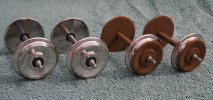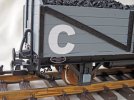Happy Jack
Registered
I've been told that plastic wheels on my freight cars create more "dust" (reduce contact) on my analog indoor layout. Is this true?
To some extent, yes..I've been told that plastic wheels on my freight cars create more "dust" (reduce contact) on my analog indoor layout. Is this true?
I've occasionally lost sight of my trains in the trees, then I hear the sound of steel on steel.... and instinctively look towards the back fence to watch the full size train go by, which isn't going by.Metal wheels will always win out in the reliably runnings stakes due to their added weight. As for noise, well it is actually quite therapeutic and will only be tedious if you had some large rail gaps IMHO.
As above, little bit of oxidising and arcing and the plastic wheels will pick this up and transfer it around the layout.I have plastic wheels on my rolling stock and have noticed a brass colored film develop on the black wheels. I thought it was from the brass track, but now I am not sure after reading other posts, which do not mention this. So why are my wheels getting a brass colored build up?
When it rained and snowed, no doubt. At open houses in Arizona people did not leave plastic houses on the layout except for the open house day!!
That's not brass, it's gold! You've cracked the mystery of alchemy!I have plastic wheels on my rolling stock and have noticed a brass colored film develop on the black wheels. I thought it was from the brass track, but now I am not sure after reading other posts, which do not mention this. So why are my wheels getting a brass colored build up?
Don't mess about, change to steel wheels.I've been told that plastic wheels on my freight cars create more "dust" (reduce contact) on my analog indoor layout. Is this true?
Although you are certainly right, but, to be fair, some people have used plastic wheels for years.Don't mess about, change to steel wheels.
There are many good reasons for going metal, no good reasons for using plastic
So here is the original question. (and his only post on this thread)I've been told that plastic wheels on my freight cars create more "dust" (reduce contact) on my analog indoor layout. Is this true?
That means my trains are now worth a lot more money. HaWhen it rained and snowed, no doubt

That's not brass, it's gold! You've cracked the mystery of alchemy!
So are you saying that the LGB plastic wheels are not made with the same compounds?Zman, there are many different compounds of plastic, so I would think some metal transfer could be possible, you could try checking the tread surface for conductivity just for grins. (Use an ohmmeter on a high scale, not a test light)
I doubt if this will cause any issues, but not sure trying to clean this off the wheels would not damage the plastic.
Greg


